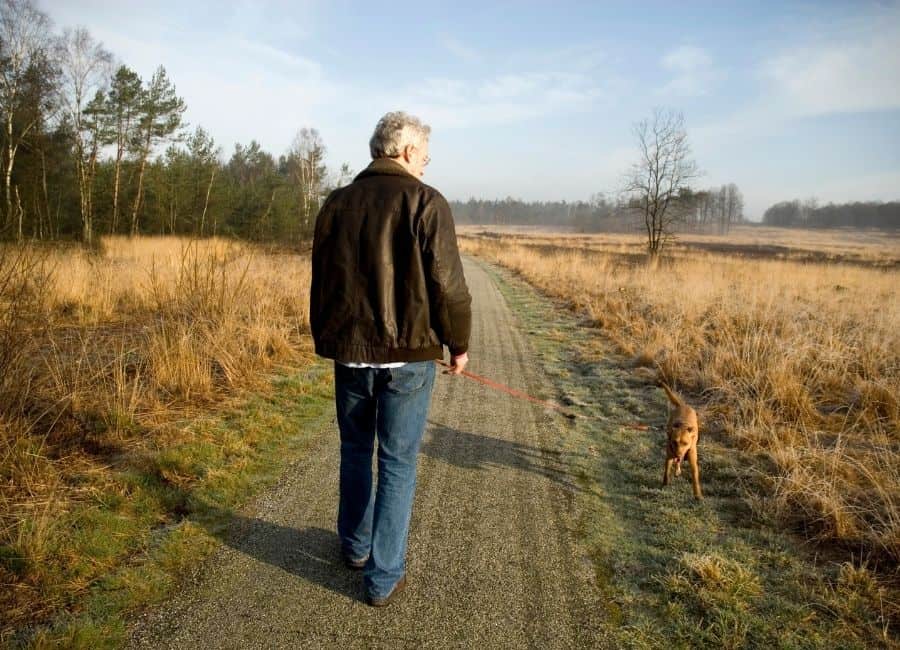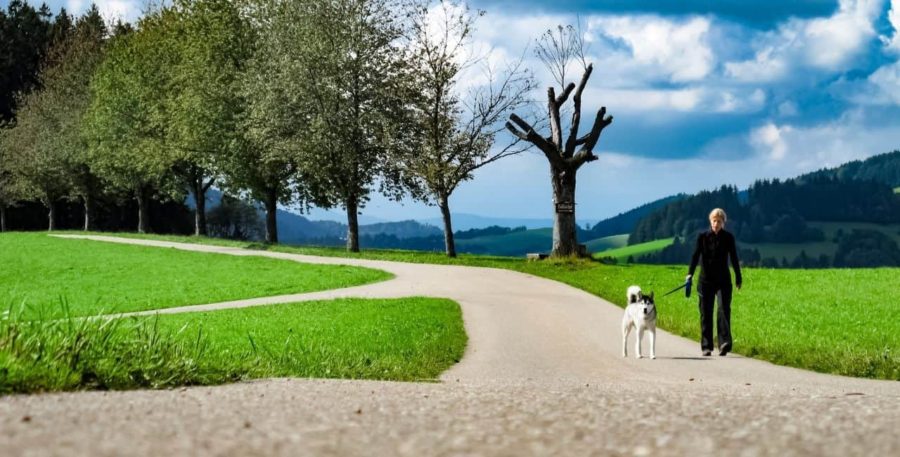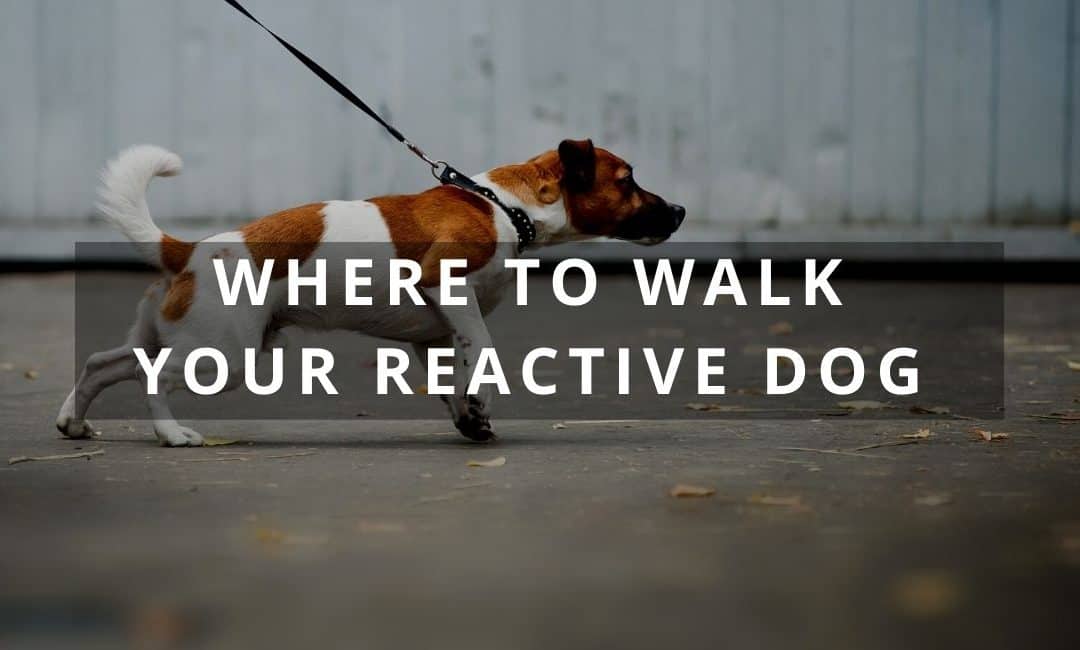If you have a reactive dog – one that barks, growls, jumps, or even simply gets way too excited anytime he sees some new dog or person in his environment – you know how stressful walks can be.
You’re always on the alert for things your dog may overreact to. Instead of enjoying the fresh air and sights, you’re uptight and nervous, constantly scanning for problems. And instead of feeling refreshed and rejuvenated after walking your dog, you’re worn out, on edge, and often embarrassed!
Every reactive dog needs training and behavior work to make sure his reactivity gets better over time. But carefully choosing where you walk can make a huge difference in your dog’s ability to relax out in public – and yours, too.
Having places to walk that don’t trigger your dog’s reactivity is also important from a training point of view. While your dog is learning how to accept new people/dogs on walks, it’s crucial he isn’t being pushed past his threshold of what he can accept calmly and confidently.
So, even while you’re dog is improving, you’re likely to need some good places to walk that don’t trigger reactive behavior.

Exercising and socializing a reactive dog often means finding areas outside your immediate neighborhood to walk your dog.
When trying a new place to walk a reactive dog, consider scoping it out first by walking it without your dog, and at the time of day you plan to walk. A quick drive-by may or may not reveal problem spots that could require you to make alternative plans or rule out the walk.
What to look for in places to walk a reactive dog
Reactive dogs should be walked in areas that give you the ability to move away from whatever things set your dog off. For most people, this means:
- No narrow spots to trap you and your dog. How narrow is too narrow will depend on you, your dog, and where he is in his training. Use your best judgment.
- Ideally, no blind curves or corners where “threats” can appear suddenly and from out of nowhere.
- Enough room on either side to move away if you feel your dog needs the additional space.
- Alternatively, it’s certainly possible to use the physical objects along your walk to block visual access to what your dog reacts to. These could be trees, card, benches… If you are not able to get to walking areas with open spaces and no blind spots, this could be a good second-best choice.
What to avoid when choosing where to walk reactive dogs
You will need to evaluate particulars for yourself, but when I walk or work with a dog that gets worked up about seeing strange dogs and/or people, I try to avoid:
- Narrow walks, sidewalks, close pathways… any and all places that don’t allow you to move away from things that cause your dog to react.
- Any neighborhoods (often rural or suburban, but not always) where loose dogs are a problem. Nothing is worse for a reactive dog than being jumped by free-running dogs while on a leash. I always recommend scoping out an area first – without your dog – before adopting a new route.
- And this may be obvious (or not) but I recommend avoiding walking your reactive dog in any places that make you tense and anxious. If a particular spot makes you feel uptight, on the alert, scanning and waiting for the bogey man to jump out, it’s very unlikely your dog is going to be cool and relaxed. The vast majority of dogs will pick up on your energy and respond accordingly.

The photo above shows a perfect example of a walk that accommodates reactive dogs, with plenty of space to move aside and create distance between your dog and distractions and triggers.
Examples of good places to walk reactive dogs
Of course, the actual places available to you will depend on where you live and how easy it is for you to get to places. But here are some examples and ideas to get you thinking, that have been successful for owners of reactive dogs:
- Open parks and beaches
- Ball fields
- Medical parks on weekends or after hours
- Car (sales) lots
- Large church parking lots
- Many churches also have playfields and green spaces
- Business parking lots (when not so busy that it’s unsafe to walk)
- Industrial “parks†(i.e. lots surrounding warehouses and other industrial buildings)
- Cemeteries (where allowed)
- Strip malls
- College campuses
Most of the places above have busy times and “dead” times (appropriate for walking reactive dogs), and they are laid out so that you can choose a route that gives you plenty of room to move away from other animals or people.
If you are tense and anxious walking a particular route, you’ll have a hard time convincing your dog to be calm and casual.
Start out by walking in places you feel at ease, and that fit your dog’s needs at the time.
Over time, expand the envelope of locations both you and your dog are comfortable and confident walking in.
If your reactive dog alerts worse in quiet locales
Some dogs are mainly reactive when strange people or dogs appear out of nowhere, or when they appear in the distance when no one else is around.
For these dogs, walking in lonely, quiet locales may actually be worse for triggering alerting, barking, and lunging. For this type of dog, you might actually be better choosing high-traffic areas for your regular walks.
If traveling to walk your reactive dog isn’t practical
If your living situation doesn’t allow for daily drives to suitable walking areas for your reactive dog, consider walking at times of day when your dog is unlikely to be triggered.
The exact time of day will depend on whether you live in the city, suburbs, or a rural area. Many owners of reactive dogs walk very late or very early in order to exercise their dog with minimal upset and stress.
That said, even if it’s not practical for you to travel to a reactive-dog-friendly spot every day, it may be something you can fit in on weekends, or even once or twice a month.
Even done less frequently, these less stressful, less triggering walks can be super helpful for improving your reactive dog’s behavior.
